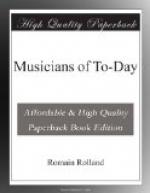Berlioz’s other great originality lay in his talent for music that was suited to the spirit of the common people, recently raised to sovereignty, and the young democracy. In spite of his aristocratic disdain, his soul was with the masses. M. Hippeau applies to him Taine’s definition of a romantic artist: “the plebeian of a new race, richly gifted, and filled with aspirations, who, having attained for the first time the world’s heights, noisily displays the ferment of his mind and heart.” Berlioz grew up in the midst of revolutions and stories of Imperial achievement. He wrote his cantata for the Prix de Rome in July, 1830, “to the hard, dull noise of stray bullets, which whizzed above the roofs, and came to flatten themselves against the wall near his window."[93] When he had finished this cantata, he went, “pistol in hand, to play the blackguard in Paris with the sainte canaille.” He sang the Marseillaise, and made “all who had a voice and heart and blood in their veins"[94] sing it too. On his journey to Italy he travelled from Marseilles to Livourne with Mazzinian conspirators, who were going to take part in the insurrection of Modena and Bologna. Whether he was conscious of it or not, he was the musician of revolutions; his sympathies were with the people.
[Footnote 93: Memoires, I, 155.]
[Footnote 94: These words are taken from Berlioz’s directions on the score of his arrangement of the Marseillaise for full orchestra and double choir.] Not only did he fill his scenes in the theatre with swarming and riotous crowds, like those of the Roman Carnival in the second act of Benvenuto (anticipating by thirty years the crowds of Die Meistersinger), but he created a music of the masses and a colossal style. His model here was Beethoven; Beethoven of the Eroica, of the C minor, of the A, and, above all, of the Ninth Symphony. He was Beethoven’s follower in this as well as other things, and the apostle who carried on his work.[95] And with his understanding of material effects and sonorous matter, he built edifices, as he says, that were “Babylonian and Ninevitish,"[96] “music after Michelangelo,"[97] “on an immense scale."[98]
[Footnote 95: “From Beethoven,” says Berlioz, “dates the advent in art of colossal forms” (Memoires, II, 112). But Berlioz forgot one of Beethoven’s models—Haendel. One must also take into account the musicians of the French revolution: Mehul, Gossec, Cherubini, and Lesueur, whose works, though they may not equal their intentions, are not without grandeur, and often disclose the intuition of a new and noble and popular art.]
[Footnote 96: Letter to Morel, 1855. Berlioz thus describes the Tibiomnes and the Judex of his Te Deum. Compare Heine’s judgment: “Berlioz’s music makes me think of gigantic kinds of extinct animals, of fabulous empires.... Babylon, the hanging gardens of Semiramis, the wonders of Nineveh, the daring buildings of Mizraim.”]




